1998 CHEVROLET CAVALIER inflation pressure
[x] Cancel search: inflation pressurePage 211 of 400
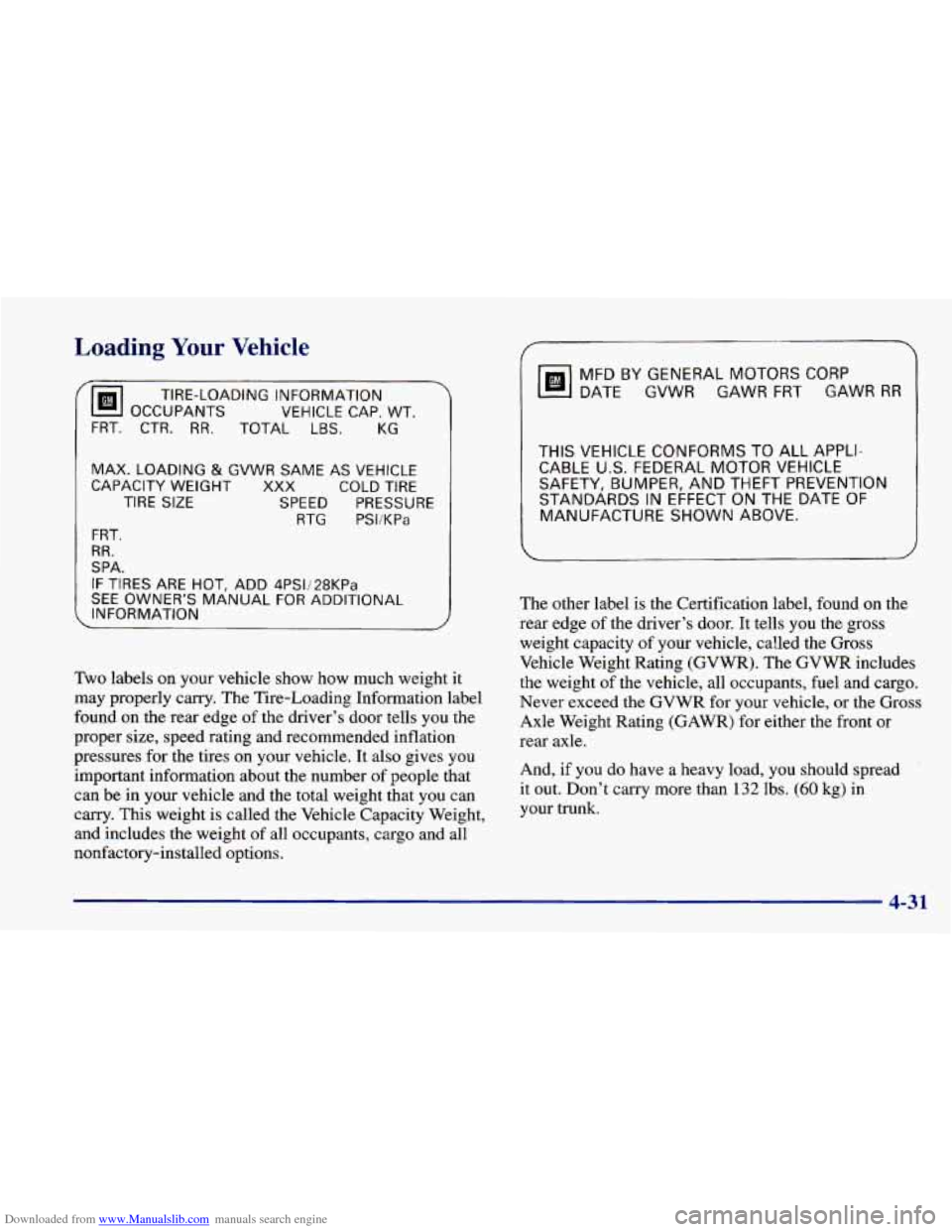
Downloaded from www.Manualslib.com manuals search engine Loading Your Vehicle
TIRE-LOADING INFORMATION
OCCUPANTS VEHICLE
CAP. WT.
FRT. CTR. RR. TOTAL LBS. KG
MAX. LOADING & GVWR SAME AS VEHICLE
CAPACITY WEIGHT XXX COLD TIRE
TIRE SIZE SPEED PRESSURE
RTG PSI/KPa
FRT,
RR.
SPA.
IF TIRES ARE HOT, ADD 4PSIi28KPa
SEE OWNER‘S MANUAL FOR ADDITIONAL
INFORMATION
Two labels on your vehicle show how much weight it
may properly carry, The Tire-Loading Information label
found on the rear edge
of the driver’s door tells you the
proper size, speed rating and recommended inflation
pressures for the tires on your vehicle. It also gives you
important information about the number
of people that
can be in your vehicle and the total weight that you can
carry. This weight is called the Vehicle Capacity Weight,
and includes the weight of all occupants, cargo and
all
nonfactory-installed options.
MFDBYGENERALMOTORSCORP
DATE GVWR
GAWR FRT GAWR RR
THIS VEHICLE CONFORMS TO ALL APPLI-
CABLE
US. FEDERAL MOTOR VEHICLE
SAFETY, BUMPER, AND THEFT PREVENTION
STANDARDS
IN EFFECT ON THE DATE OF
MANUFACTURE SHOWN ABOVE.
The other label is the Certification label, found on the
rear edge of the driver’s door. It tells you the gross
weight capacity
of your vehicle, called the Gross
Vehicle Weight Rating
(GVWR). The GVWR includes
the weight of the vehicle, all occupants, fuel and cargo.
Never exceed the GVWR for your vehicle, or the Gross
Axle Weight Rating (GAWR) for either the front or
rear axle.
And,
if you do have a heavy load, you should spread
it out. Don’t carry more than
132 lbs. (60 kg) in
your trunk.
4-31
Page 255 of 400
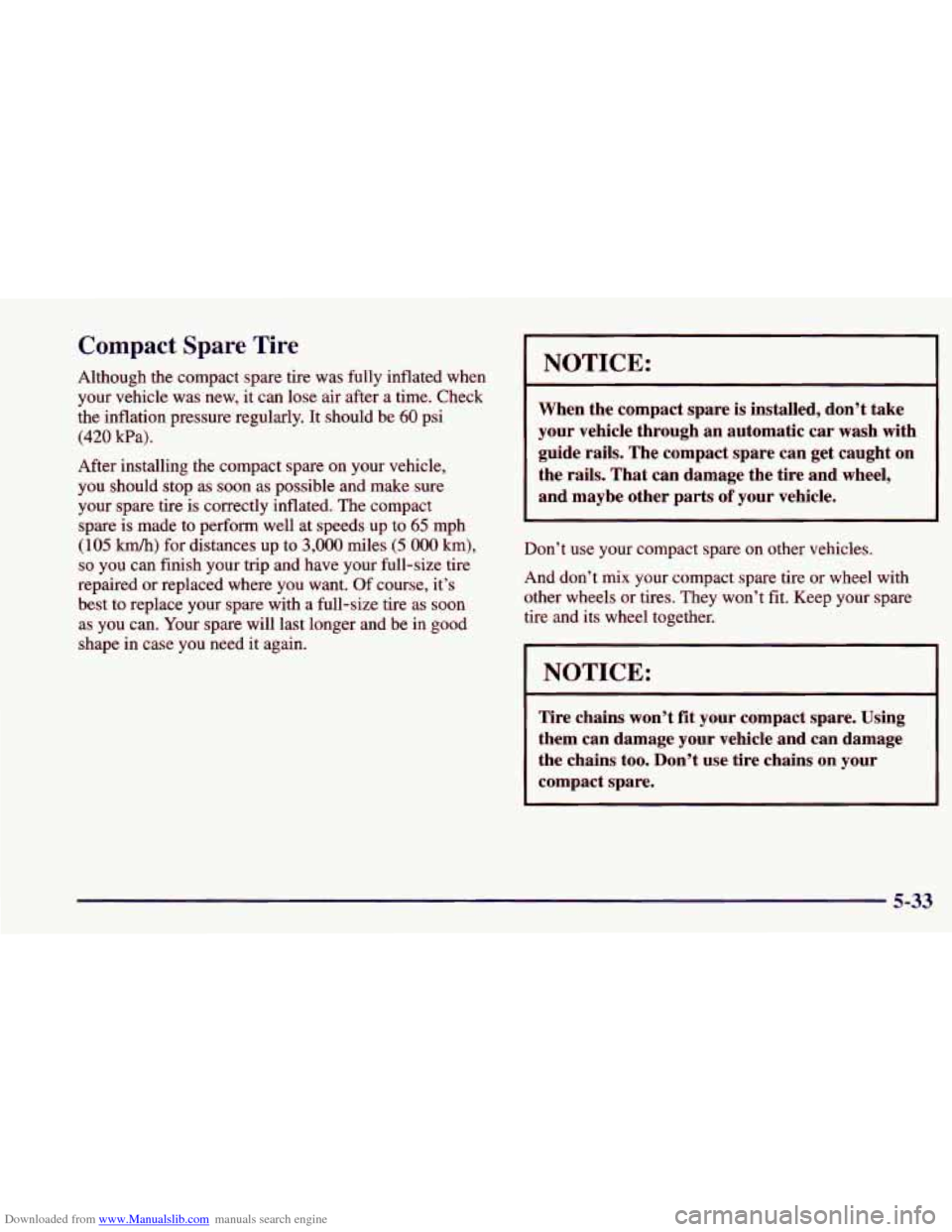
Downloaded from www.Manualslib.com manuals search engine Compact Spare Tire
Although the compact spare tire was fully inflated when your vehicle was new, it can lose air after a time. Check
the inflation pressure regularly. It should be
60 psi
(420 Wa).
After installing the compact spare on your vehicle,
you should stop as soon as possible and make sure
your spare
tire is correctly inflated. The compact
spare is made to perform well
at speeds up to 65 mph
( 105 km/h) for distances up to 3,000 miles (5 000 km),
so you can finish your trip and have your full-size tire
repaired or replaced where you want.
Of course, it’s
best to replace your spare with a full-size tire as soon
as you can. Your spare will last longer and be in good
shape in case you need it again.
NOTICE:
When the compact spare is installed, don’t take
your vehicle through an automatic car wash with
guide rails. The compact spare can get caught on
the rails. That can damage the tire and wheel,
and maybe other parts
of your vehicle.
Don’t use your compact spare on other vehicles.
And don’t mix your compact spare tire or wheel with
other wheels or tires. They won’t fit. Keep your spare
tire and its wheel together.
NOTICE:
Tire chains won’t fit your compact spare. Using
them can damage your vehicle and can damage
the chains too. Don’t use tire chains
on your
compact spare.
5-33
Page 299 of 400
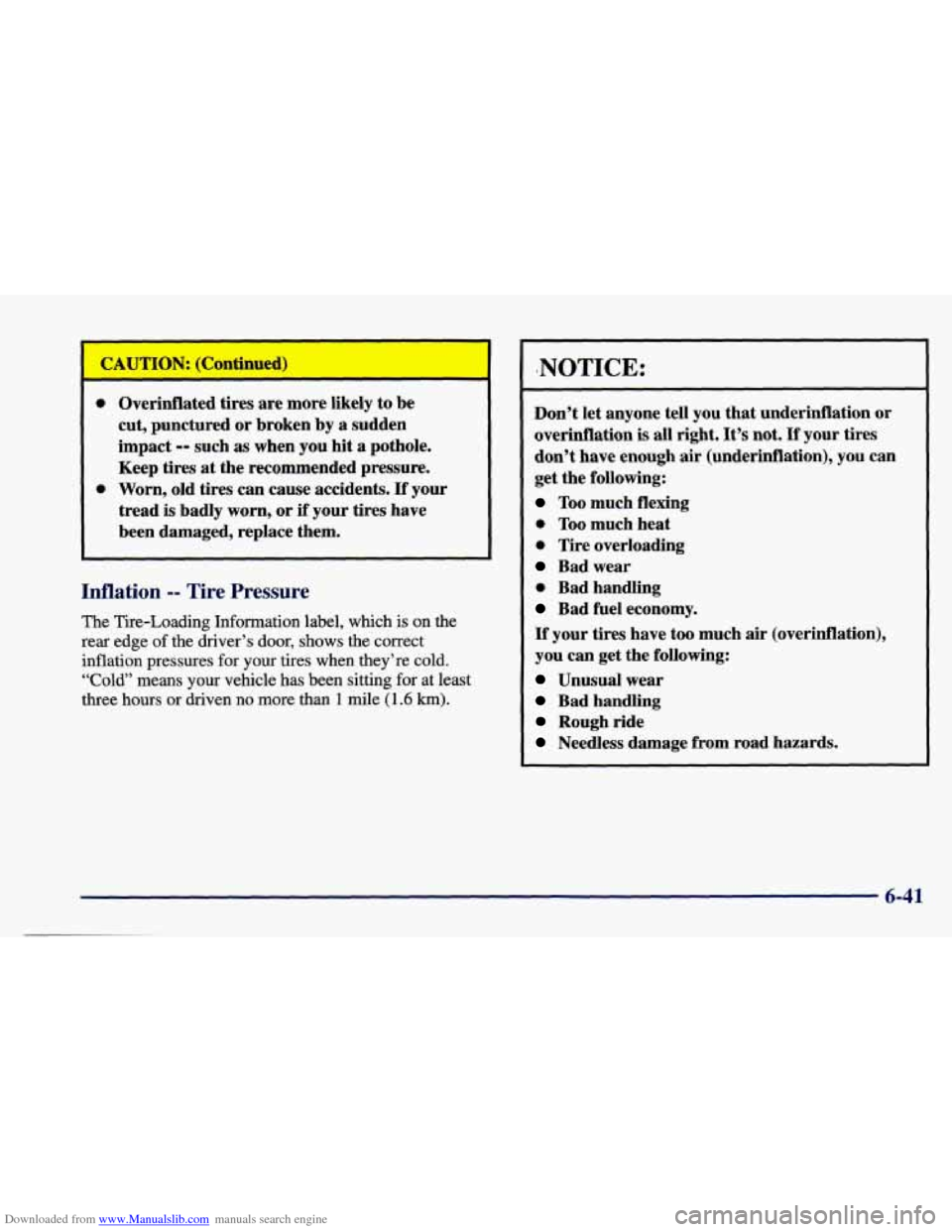
Downloaded from www.Manualslib.com manuals search engine ___ JTION: ( ontin
0 Overinflated tires are more likely to be
cut, punctured or broken
by a sudden
impact
-- such as when you hit a pothole.
Keep tires at the recommended pressure.
0 Worn, old tires can cause accidents. If your
tread is badly worn, or
if your tires have
been damaged, replace them.
Inflation -- Tire Pressure
The Tire-Loading Information label, which is on the
rear edge
of the driver’s door, shows the correct
inflation pressures for your tires when they’re cold.
“Cold” means your vehicle has been sitting for at least
three hours
or driven no more than 1 mile (1.6 km).
!NOTICE:
Don’t let anyone tell you that underinflation or
overinflation is all right.
It’s not. If your tires
don’t have enough air (underinflation), you can
get the following:
Too much flexing
0 Too much heat
0 Tire overloading
Bad wear
0 Bad handling
Bad fuel economy.
If your tires have too much air (overinflation),
you can get the following:
Unusual wear
Bad handling
Rough ride
Needless damage from road hazards.
6-41
Page 301 of 400
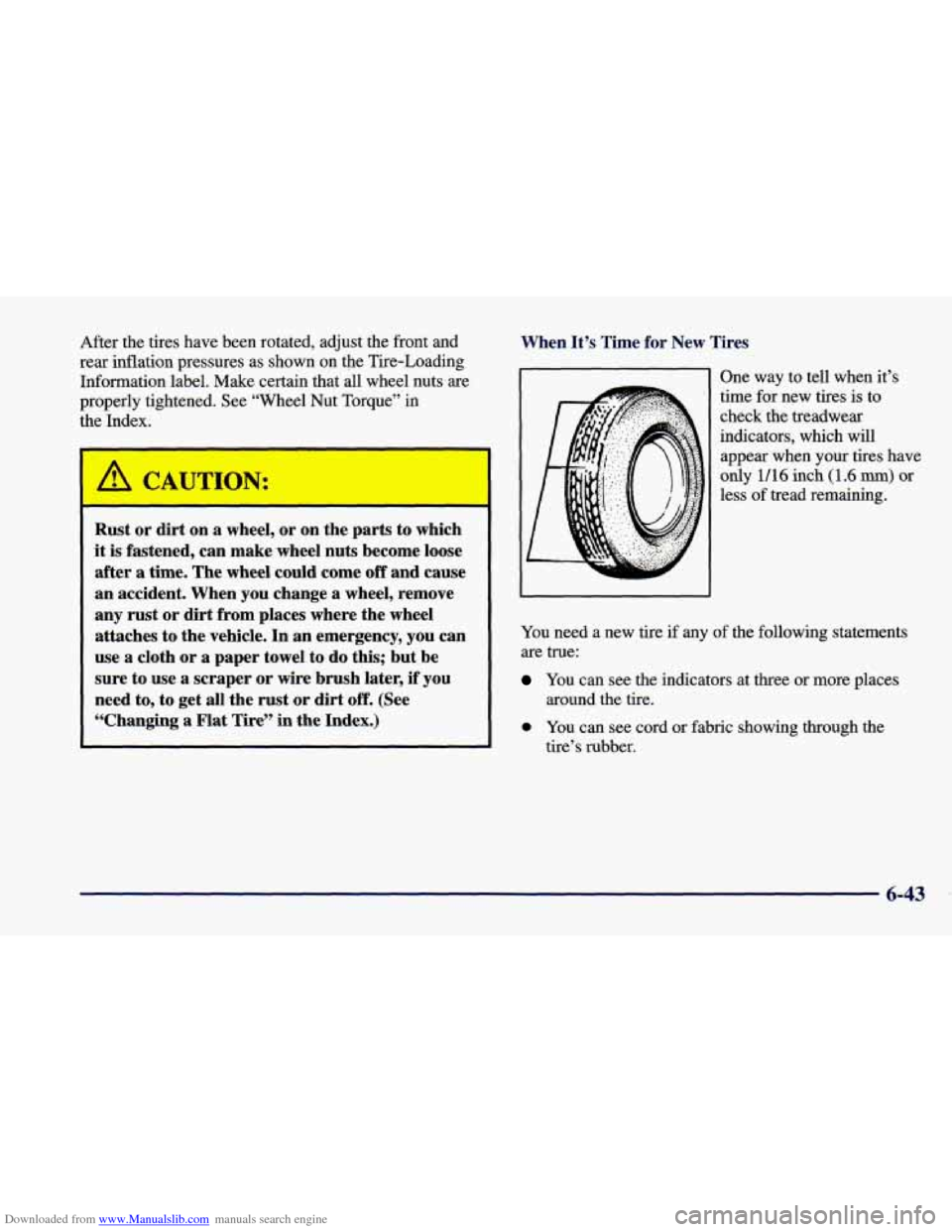
Downloaded from www.Manualslib.com manuals search engine After the tires have been rotated, adjust the front and
rear inflation pressures as shown on the Tire-Loading Information label. Make certain that all wheel nuts are
properly tightened. See “Wheel Nut Torque”
in
the Index.
Rust or dirt on a wheel, or on the parts to which
it is fastened, can make wheel nuts become loose
after a time. The wheel could come
off and cause
an accident. When you change a wheel, remove
’ any rust or dirt from places where the wheel
1 attaches to the vehicle. In an emergency, you can
use a cloth or a paper towel to do this; but be
~ sure to use a scraper or wire brush later, if you
1 need to, to get all the rust or dirt off. (See
“Changing a
Flat Tire” in the Index.) When It’s Time
for
New Tires
One way to tell when it’s
time for new tires is to
check
the treadwear
indicators, which will appear when your tires have
only
1/16 inch (1.6 mm) or
less of tread remaining.
You need a new tire if any of the following statements
are true:
You can see the indicators at three or more places
around the tire.
0 You can see cord or fabric showing through the
tire’s rubber.
Page 356 of 400
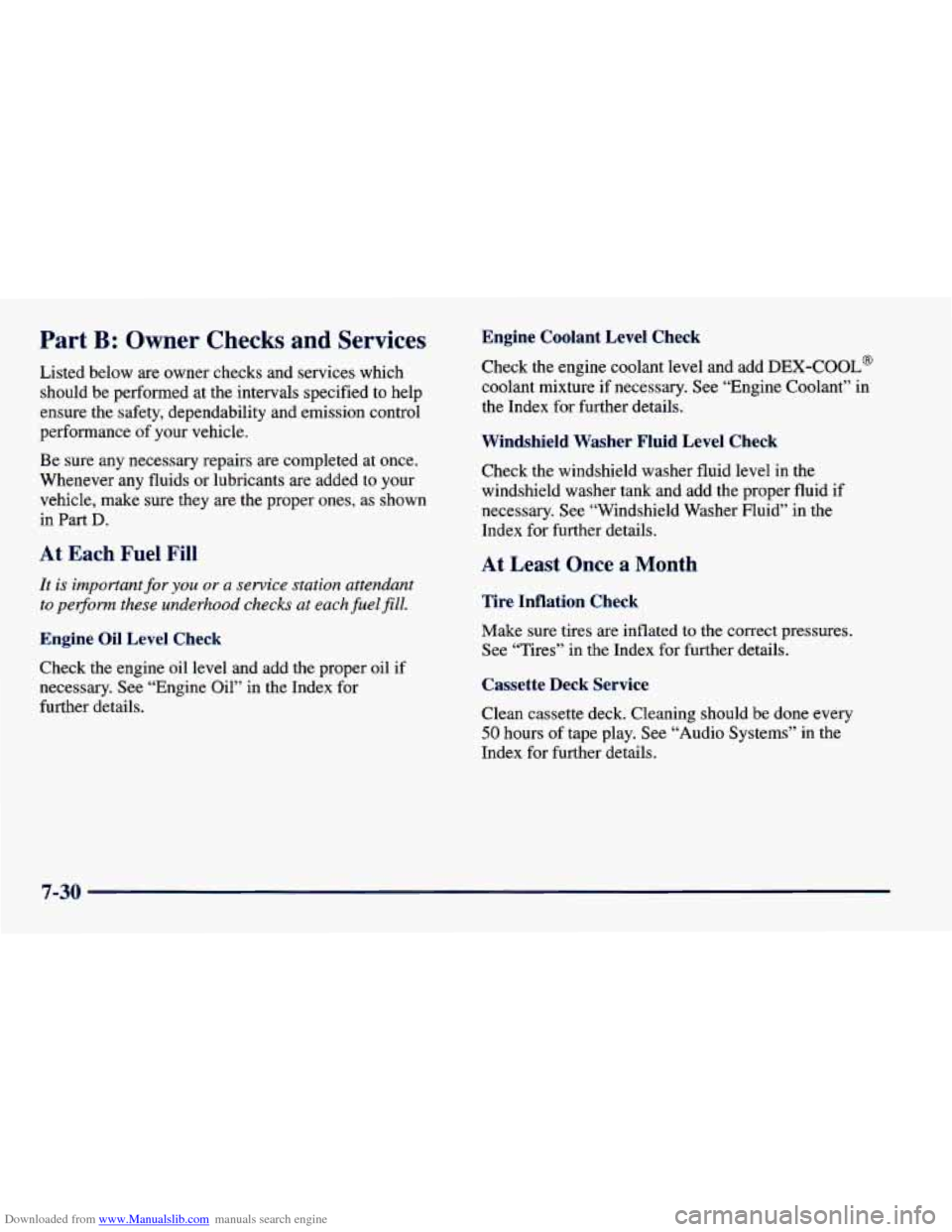
Downloaded from www.Manualslib.com manuals search engine Part B: Owner Checks and Services
Listed below are owner checks and services which
should be performed at the intervals specified to help
ensure the safety, dependability and emission control
performance of your vehicle.
Be sure any necessary repairs are completed at once.
Whenever any fluids
or lubricants are added to your
vehicle, make sure they are the proper ones, as shown
in Part
D.
At Each Fuel Fill
It is important for you or a service station attendant
to petjiorrn these underhood checks at each fuel
fill.
Engine Oil Level Check
Check the engine oil level and add the proper oil if
necessary. See “Engine Oil” in the Index for
further details.
Engine Coolant Level Check
Check the engine coolant level and add DEX-COOL@
coolant mixture if necessary. See “Engine Coolant” in
the Index for further details.
Windshield Washer Fluid Level Check
Check the windshield washer fluid level in the
windshield washer tank and add the proper fluid if
necessary. See “Windshield Washer Fluid” in the
Index for further details.
At Least Once a Month
Tire Inflation Check
Make sure tires are inflated to the correct pressures.
See “Tires” in the Index for further details.
Cassette Deck Service
Clean cassette deck. Cleaning should be done every
50 hours of tape play. See “Audio Systems” in the
Index for further details.
7-30
Page 393 of 400
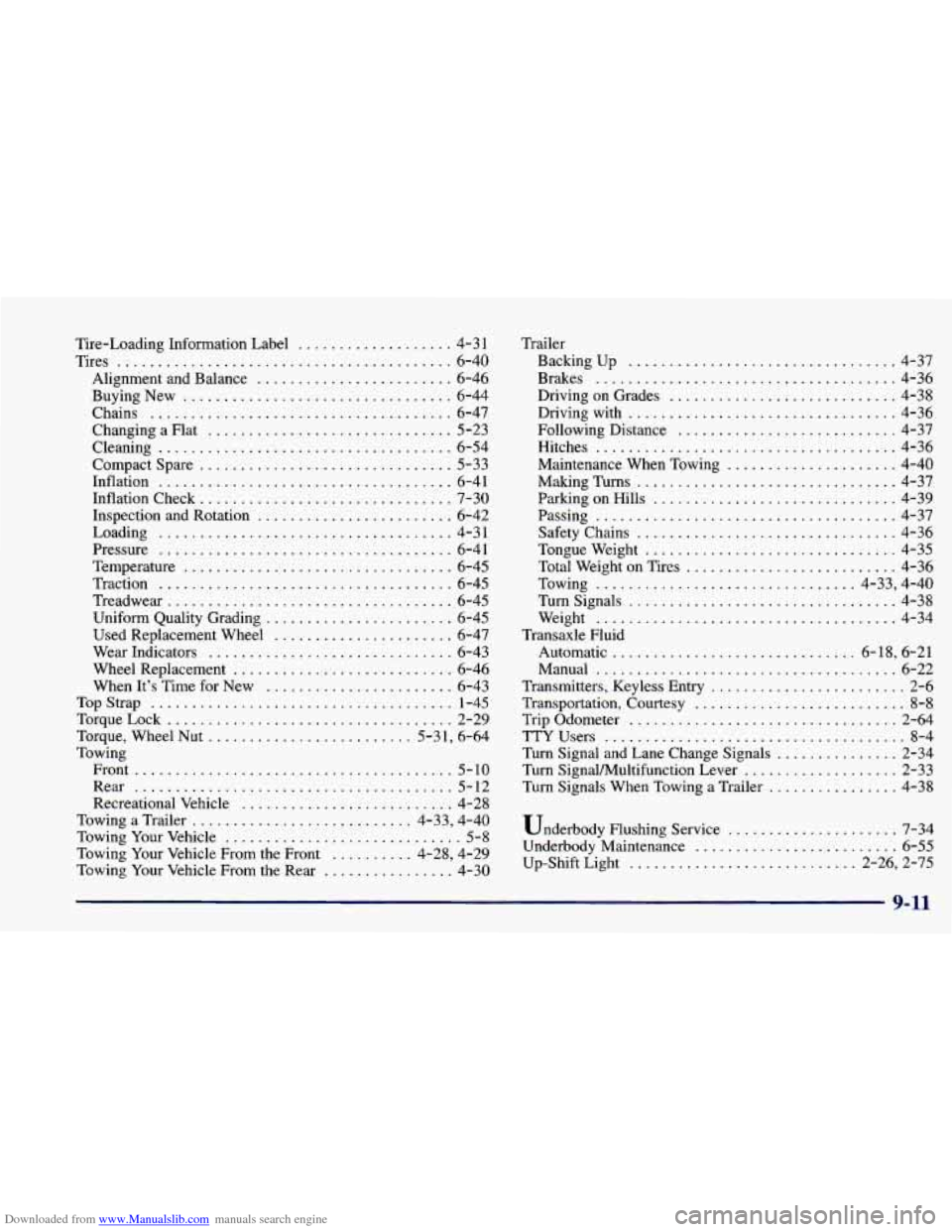
Downloaded from www.Manualslib.com manuals search engine Tire-Loading Information Label ................... 4-3 1
Tires
......................................... 6-40
Alignment and Balance
........................ 6-46
BuyingNew
................................. 6-44
Chains
..................................... 6-47
ChangingaFlat
.............................. 5-23
Cleaning
.................................... 6-54
Compact Spare
............................... 5-33
Inspection and Rotation
........................ 6-42
Inflation
.................................... 6-41
Inflation Check
............................... 7-30
Loading
.................................... 4-31
Pressure
.................................... 6-41
Temperature
................................. 6-45
Traction
.................................... 6-45
Treadwear
................................... 6-45
Uniform Quality Grading
....................... 6-45
Used Replacement Wheel
...................... 6-47
Wear Indicators
.............................. 6-43
When It’s Time for New ....................... 6-43
TopStrap
..................................... 1-45
TorqueLock ................................... 2-29
Towing Wheel Replacement
........................... 6-46
Torque, Wheel Nut
......................... 5-31, 6-64
Front
....................................... 5-10
Rear
....................................... 5-12
Recreational Vehicle
.......................... 4-28
Towing
a Trailer ........................... 4-33, 4-40
Towing Your Vehicle
............................. 5-8
Towing Your Vehicle From the Front
.......... 4-28, 4-29
Towing Your Vehicle From
the Rear ................ 4-30 Trailer
Backingup
................................. 4-37
Brakes
..................................... 4-36
Driving on Grades
............................ 4-38
Driving with
................................. 4-36
Following Distance
........................... 4-37
Maintenance When Towing
..................... 4-40
MakingTurns
................................ 4-37
Parking on Hills
.............................. 4-39
Safety Chains
................................ 4-36
Tongueweight
............................... 4-35
Total Weight on Tires
.......................... 4-36
Towing
................................ 4-33. 4-40
Turnsignals
................................. 4-38
Weight
..................................... 4-34
Automatic
.............................. 6- 18. 6-21
Manual
..................................... 6-22
Transmitters. Keyless Entry
........................ 2-6
Transportation. Courtesy
.......................... 8-8
TTYUsers
..................................... 8-4
Turn Signal and Lane Change Signals
............... 2-34
Turn Signalhlultifunction Lever
................... 2-33
Turn Signals When Towing
a Trailer ................ 4-38
Hitches
..................................... 4-36
Passing
..................................... 4-37
Transaxle Fluid
Trip Odometer
................................. 2-64
Underbody Flushing Service
..................... 7-34
Underbody Maintenance
......................... 6-55
Up-Shift Light
............................ 2.26. 2.75
9-11